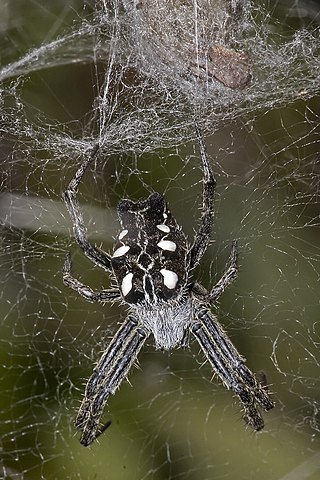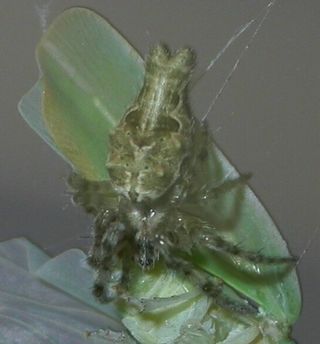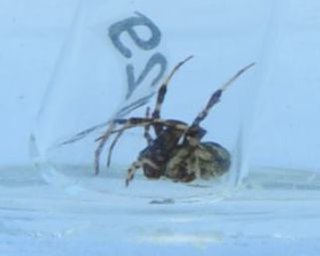
The genus Argiope includes rather large spiders that often have a strikingly coloured abdomen. These spiders are distributed throughout the world. Most countries in tropical or temperate climates host one or more species that are similar in appearance. The etymology of Argiope is from a Latin word argentum meaning silver. The carapace of Argiope species is typically covered in silvery hairs, and when crawling in the sun, they reflect it in a way that gives them a metallic, white appearance.

Orb-weaver spiders are members of the spider family Araneidae. They are the most common group of builders of spiral wheel-shaped webs often found in gardens, fields, and forests. The English word "orb" can mean "circular", hence the English name of the group. Araneids have eight similar eyes, hairy or spiny legs, and no stridulating organs.

A bolas spider is a member of the orb-weaver spider that, instead of spinning a typical orb web, hunts by using one or more sticky "capture blobs" on the end of a silk line, known as a "bolas". By swinging the bolas at flying male moths or moth flies nearby, the spider may snag its prey rather like a fisherman snagging a fish on a hook. Because of this, they are also called angling or fishing spiders. The prey is lured to the spider by the production of up to three sex pheromone-analogues.

Micrathena, known as spiny orbweavers, is a genus of orb-weaver spiders first described by Carl Jakob Sundevall in 1833. Micrathena contains more than a hundred species, most of them Neotropical woodland-dwelling species. The name is derived from the Greek "micro", meaning "small", and the goddess Athena.

Argiope protensa, commonly known as the tailed grass spider or teardrop spider, is a species of spider in the orb weaver family, Araneidae. This species is fairly common and widespread in Australasia, but like many spider species, little is known of its ecology, biology, or life history.

Cyrtophora citricola, also known as the tropical tent-web spider, is an orb-weaver spider in the family Araneidae. It is found in Asia, Africa, Australia, Costa Rica, Hispaniola, Colombia, and Southern Europe and in 2000, it was discovered in Florida. C. citricola differs from many of its close relatives due its ability to live in a wide variety of environments. In North America and South America, the spider has caused extensive damage to agricultural operations.

Arkys, also known as triangular spider or ambush spider, is a genus of Australian araneomorph spiders in the family Arkyidae, first described by Charles Athanase Walckenaer in 1837. They are often small, with a triangular shaped abdomen, and are found in Australia and some of its surrounding islands. They don't build webs, but can often be found on leaves and tips of flower heads. Their egg sacs are pinkish-orange and spherical, and are made late in the summer.

Larinia is a genus of orb-weaver spiders first described by Eugène Simon in 1874.

Allocyclosa is a genus of orb weaver spiders that contains only one species, Allocyclosa bifurca. It was first described in 1887 by McCook under the name Cyrtophora bifurca, and was transferred to its own genus in 1999. It is the only Cyclosa species north of Mexico to have a forked rear tip of the abdomen hence the name bifurca, Latin for "two-pronged". The forked tip of the abdomen, bearing two humps shaped like the letter M, is a defining feature in both males and females, though it is similar to features present in certain Cyrtophora species. Both sexes are a grey-green color, though only females have an area of red on their underside between the epigynum and the spinnerets. Females are much larger than males, ranging from five to nine millimeters, while males range from two to three millimeters. Males appear to be very uncommon, but they are probably often overlooked by collectors due to their small size. In a 1977 study by Levi, only two of the nearly 350 specimens that were positively identified as Cyrtophora bifurca were males. This is a very unusual distribution; a second, less likely explanation that has been proposed is that females of the species, which have less prominent genitalia compared with those of other members of the orb-weaver family, may be parthenogenic, are able to reproduce without the help of males. Like most other members of Araneidae, these spiders build orb webs, six to eight inches in diameter, but employ an unusual form of protective mimicry. Females often sit in the middle of a vertical row of web decoration that include egg sacs and wrapped prey. Because the spider and the egg sacs have a similar color and shape, it is difficult to distinguish the egg sacs from the spider itself.
Cyrtobill is a genus of Australian orb-weaver spiders containing the single species, Cyrtobill darwini. It was first described by V. W. Framenau & N. Scharff in 2009, and has only been found in Australia.

Demadiana is a genus of Australian araneomorph spiders in the family Arkyidae, first described by Embrik Strand in 1929.
Exechocentrus is a genus of Madagascan orb-weaver spiders first described by Eugène Simon in 1889. It is a bolas-using spider, capturing its prey with one or more sticky drops at the end of a single line of silk rather than in a web.

Mecynogea is a genus of orb-weaver spiders first described by Eugène Simon in 1903. The name is derived from the Greek mekyno (μηυνω), meaning "to lengthen", and "gea" (γεα), meaning "earth".

Cyrtarachninae is a subfamily of spiders in the family Araneidae. The group has been circumscribed in several different ways. It originated as the group Cyrtarachneae, described by Eugène Simon in 1892. The group was later treated at different ranks: as a tribe, both under Simon's name and as Cyrtarachnini, and as the subfamily Cyrtarachninae. Circumscriptions have varied. The broadest circumscription, Cyrtarachninae sensu lato (s.l.), includes three of Simon's original groups, including the bolas spiders. Unlike most araneids, members of the subfamily do not construct orb webs, some not using webs at all to capture prey, some using one or more sticky drops on a single line, while others construct webs with few widely spaced non-spiral threads, some triangular. Many have been shown to attract prey by producing analogues of insect sex pheromones, particularly to attract male moths. Adult females may mimic snails, bird droppings and other objects, and so are able to remain exposed during the day time, capturing prey at night.
Exechocentrus lancearius is a species of spider in the orb-weaver spider family Araneidae, found only in Madagascar. It was initially described from a partial specimen of an adult female. The first description of a complete specimen and its prey-catching behaviour was published in 2012. E. lancearius is a bolas spider. Rather than using a web, adult females catch their prey by using a line with one or two sticky drops which they swing.

Ordgarius sexspinosus is a species of spider in the orb-weaver spider family Araneidae, found from India to Japan and Indonesia. O. sexspinosus is a bolas spider. Rather than using a web, adult females catch their prey by using a line with one or two sticky drops which they swing.

Hortophora is a genus of South Pacific orb-weaver spiders first described by V. W. Framenau, R. L. C. Baptista and F. S. M. Oliveira in 2021.

Gea eff is a species of orb-weaver spider. It is found in Papua New Guinea. The arachnologist Herbert Walter Levi formally described the species in 1983. While it was still undescribed, Michael H. Robinson and colleagues reported on its courtship and mating behaviors. Gea eff has the shortest scientific name of any spider species.

Salsa fuliginata, commonly known as the sooty orbweaver, is a orb-weaver spider of Araneidae in the genus Salsa. The species is found throughout southeastern Australia and New Zealand.



















